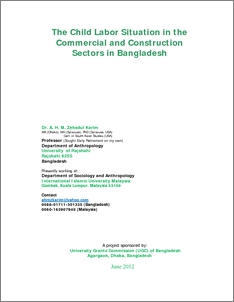Karim, A.H.M Zehadul
(2012)
The child labor situation in the commercial and construction sectors in Bangladesh.
Project Report.
University Grants Commission (UGC) of Bangladesh, Agragon, Dhaka, Bangladesh, Dhaka, Bangladesh.
(Unpublished)
![[img]](http://irep.iium.edu.my/style/images/fileicons/application_pdf.png)  Preview |
|
PDF ( The child labor situation in the commercial and construction sectors in Bangladesh)
- Published Version
Download (76kB)
| Preview
|
Abstract
The participation of under-aged children as child labor in multifarious work-activities is a widespread phenomena throughout the world. Although, child labor is legally restricted in many countries of the world, yet the International Labor Organization (ILO) estimated that there were about 40 million children below 15 years of age who were engaged in paid employment in 1985; and in spite of repeated penalties declared by many nations, the number still remained at 34 million until 1988 (see Jomo 1992). A recent ILO survey indicated that 73 million world’s children are employed as an equivalent to 13 per cent of those aged 10 to 14 is another example of this issue (see ILO 1996). As we come to accept the fact that there are millions of under-aged children who are employed as potential labor-force throughout the world, the imposition of laws could not however, control the family employment when people find it an easy means to circumvent the regulations. It is therefore quite likely that the participation of the children from the low income families in both domestic and non-domestic sectors of production will continue to increase in future. And there is no doubt that this sort of patronization of child labor must have some detrimental effect on their schooling and of children’s future socialization process.
In identifying the main causes of educational wastage in India, it emerged from a research (see Rawat and Goyal 1975) that 65 per cent of the children are withdrawn from schools long before they could complete their elementary courses only because that they work either at home or in their family farm especially after nine years. A similar pattern has also been observed in Bangladesh when the main reasons of children’s drop-out in primary education were identified in the fact that their parents and guardians were unable to bear their educational expenses in schools (for details see Karim (1995). And the research further confirmed that instead of sending them to schools, the parents send their children either to earn their family subsistence or get them employed in multifarious works with their parents.
In peninsular Malaysia, we can apparently say that children’s employment in the labor-force has appreciably been declined due to its rapid expansion of elementary education and the promotion of schooling facilities. Although there is a declining trend in child-employment in Malaysia, but it has not been totally eradicated as yet. In Turkey, a 1989 study indicated that 60 per cent of the workers involved in cotton cultivation were either 20 years old or younger in them (see Unicef 1997). The same study (see Unicef 1997) further reported that children are found to comprise one-fourth of all agricultural workers in Kenya.
Whatever may be the situation, it is quite acceptable that the main reason for child employment in many parts of the world lies with the fact that most of the poor families in these countries are economically dependent on them. This is evident when Karim (1995) found that the drop-out of children from schools is one of the important reasons for child labor in Bangladesh. As these families urgently need their economic support, they become reluctant to go to schools. In spite of signing a formal Memorandum of Understanding (MOU) by the Bangladesh Garment Manufacturer Exporters Association (BGMEA) and the Unicef and ILO offices in Bangladesh in 1995. It is suspected that a large number of the children still work in the manufacturing and construction sectors in different parts of the country. The children are also found to work in other sectors, as well. We assume that their poverty-level compel them to do so.
The above discussion clearly suggests that the employment aspect of under-aged children has still remained to be an important issue in Bangladesh. And accordingly for that reason, this proposed research is an initiative to generate data on the child labor in Bangladesh by especially identifying them from the commercial and construction sectors of the country.
Actions (login required)
 |
View Item |


 Download Statistics
Download Statistics Download Statistics
Download Statistics